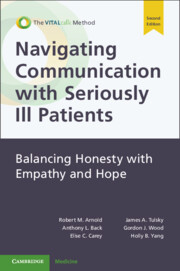Book contents
- Navigating Communication with Seriously Ill Patients
- Navigating Communication with Seriously Ill Patients
- Copyright page
- Dedication
- Reviews
- Contents
- Preface
- Acknowledgments
- 1 Taking Your Skills to the Next Level
- 2 Foundational Communication Skills
- 3 Talking about Serious News
- 4 Discussing Prognosis
- 5 Planning for the Future: Discussing What’s Important, Well Before a Crisis
- 6 Discussing Treatment Decisions
- 7 Between the Big Events
- 8 Goals of Care in Late-Stage Disease
- 9 Conducting a Family Conference
- 10 Dealing with Conflicts between Clinicians and Patients
- 11 Working Through Conflicts with Colleagues
- 12 When You’re Really Stuck
- 13 Talking about Dying
- 14 Cultivating Your Skills
- Index
- References
4 - Discussing Prognosis
A Tightrope Walk between Hope and Reality
Published online by Cambridge University Press: 05 April 2024
- Navigating Communication with Seriously Ill Patients
- Navigating Communication with Seriously Ill Patients
- Copyright page
- Dedication
- Reviews
- Contents
- Preface
- Acknowledgments
- 1 Taking Your Skills to the Next Level
- 2 Foundational Communication Skills
- 3 Talking about Serious News
- 4 Discussing Prognosis
- 5 Planning for the Future: Discussing What’s Important, Well Before a Crisis
- 6 Discussing Treatment Decisions
- 7 Between the Big Events
- 8 Goals of Care in Late-Stage Disease
- 9 Conducting a Family Conference
- 10 Dealing with Conflicts between Clinicians and Patients
- 11 Working Through Conflicts with Colleagues
- 12 When You’re Really Stuck
- 13 Talking about Dying
- 14 Cultivating Your Skills
- Index
- References
Summary
Clinicians and patients have varying degrees of comfort in discussing prognosis. Patients can swing between worry or understanding that death is near and hope or optimism that lets them live life. This prognostication awareness pendulum may require a clinician negotiate the discussion over time. The cognitive roadmap for prognosis discussion is ADAPT (Ask what they know about their medical condition, Discover what they want to know about prognosis, Anticipate ambivalence, Provide information about what to expect, and Track emotion and respond with empathy). Some patients want prognostic information, some don’t, and some are ambivalent. While respecting their wishes, exploring why in each of these scenarios may be helpful to understand their concerns and how best to address them. Be aware that patients and their family members may have different prognostic information needs. Having separate conversations (with permission) may be in order. When they are concerned about destroying hope or prognosis is uncertain, using the frame of “hope and worry” can be helpful. Finally, when patients or family members don’t believe our prognosis, be curious as to why and focus on the relationship.
- Type
- Chapter
- Information
- Navigating Communication with Seriously Ill PatientsBalancing Honesty with Empathy and Hope, pp. 52 - 75Publisher: Cambridge University PressPrint publication year: 2024



